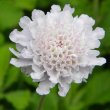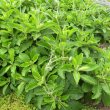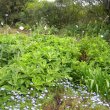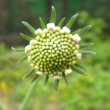| Botanical Name |
|
| Family |
Dipsacaceae - The Teasel family.
|
| Pronunciation |
skab-ee-OH-suh af-ri-KAHN-uh |
| Common Name(s) |
Afrikaans: Koringblom; Koringblommetjie
|
| Plant Group |
- Ground Cover A plant with a low-growing, spreading habit, grown specifically to cover the ground.
- Perennial A plant whose life cycle lasts for three or more seasons.
|
| Plant Size |
- Very large
| Tree | Over 25m |
| Shrub | Over 4m |
| Perennial/ground cover | Over 1m |
| Bulb | Over 1.2m |
| Succulent | 1.5m to 2m |
|
| Position |
- Partial Shade The area is in shade for part of the day and in full sun for part of the day.
- Sun The area is in full sun for all or most of the day, all year round.
|
| General Information |
- Drought Tolerance: Moderate The plant is moderately adapted to arid conditions and can survive short periods of drought and high temperatures without extra water.
- Evergreen Plants that have leaves all year round.
- Frost: Half-hardy The plant is able to survive low temperatures and some frost but requires protection against severe frost.
- Prune hard after flowering Fast growing shrubs that grow lanky within a season. Cut off branches and stems of these plants to a third of their original length. This will increase the yield of flowers, improve the plants shape and enhance the structural strength of main branches.
- Water Moderate These plants will need some extra watering compared to water-wise plants. Plant them together, in at least some shade and in a convenient proximity to the house so that grey water can be utilised during times of drought.
- Wind Tolerant Plants able to withstand the effect of strong winds.
|
| Specific Information |
Scabiosa africana is an attractive sight with the many tall flowering stems waving in the wind. The plant forms mounds of large rosettes of light green, large, velvety leaves. The thick stems that shoot from the ground attain a height of about 75 cm. The branched flower stems can grow almost 1 m above the foliage, topped with the typical scabious flowers. After flowering, tight, bristly seed-balls develop from which the shuttle-cock shaped seeds are dispersed by the wind.
|
| Ad Break |
|
| Flowers |
| Description |
small flowers clustered tightly on flattened heads about 50 mm across, on tall branched stems
|
| Season |
- Spring to Summer Plants will seldom bloom for the entire season as given in the list, but should flower during a period within these parameters.
|
| Colour |
|
| Growth Rate |
- Fast Specifying growth rate can be very misleading as there is considerable variation of growth rate depending on type and species of plant, available water, supplementary feeding, mulching and general care, as well as the plants suitability and adaptability to the garden environment.
|
| Plant Uses |
- Attracts bees, butterflies or other insects This plant attracts insects which can be food for birds or other creatures in your garden.
- Border A strip of ground, at the edge of a driveway or path in which ornamental plants or shrubs are planted.
- Cut Flowers Plants that provide flowers suitable for ornamental uses.
- Filler Either a fast growing tree or shrub used temporarily to fill in an area while the permanent plants grow to a desired size, or a plant used to fill gaps in borders or beds.
- Ground Cover Low-lying plants that spread fast, require minimal maintenance, and cover large expanses or bare areas between bulbs or shrubs. They provide protection from erosion and drought and improve the visual appearance of the garden.
- Suitable for coastal gardens Plants adapted to dry, sandy soil, forceful wind, limited rainfall and intense sunlight.
|
| Distribution and Habitat |
in the Western Cape along the sheltered sandstone slopes of the Cape Peninsula, among the fynbos
|
| Planting Suggestions |
Scabiosa africana requires full sun to semi-shade and good garden soil mixed with compost. The plants grow fast and usually flower within their first year. As the older plants get untidy they can be renewed by cutting the old long woody stalks right back to the base after flowering. Seed can be sown in autumn or spring and will germinate in about 3 weeks. The seedlings transplant easily and are hardy to winter cold. Water well until established and moderately thereafter. After three or four seasons it may be necessary to uproot and replace the old plants.
|
| Lorraine's Garden Notes |
I have frequent problems with rust on the leaves and with aphids on the flower stems and buds. In my garden they do not flower as impressively as I had hoped (thanks to the aphids) but they do make a most attractive ground cover for most of the year. After flowering I cut them right down to the ground, and remove any plants that are past their best.
|
| Medicinal Uses |
|
| Ad Break |
|











Discuss this plant
Share knowledge, ask a question or give an experience.